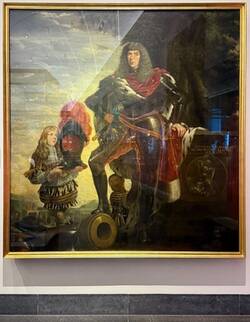With the end of the Thirty Years‘ War, the era of the suit of armour had passed. There are some examples, called cuirasses, which dispense with any protection for the arms and legs. The armours you see here were designed for use in battle. They were made in the late sixteenth century, mostly during the Thirty Years‘ War. Elector Johann Georg I and his son, Johann Georg II, wore them in action.
Some of these very heavy-looking armours weigh 40 kilos or more; that’s a lot more than suits from previous centuries. And they no longer protect the entire body, because they’re three-quarter armours, known as “Pappenheimers”.
Imperial Count and Field Marshal Gottfried Heinrich zu Pappenheim fitted out his horsemen in armours like these. They wore leather boots, not iron, and often had an open helmet, called a morion. This gave them more freedom of movement. On the other hand, the strong breastplates, which were sometimes even double-thickness, provided protection against bullets fired from wheel-lock pistols.
The blackened armour with the white leather belt and buckles belonged to Elector Johann Georg I. It’s very simple. But the helmet’s peaked visor, reminiscent of a veil pierced by a spike, makes it look rather oriental. In the display case next to the platform, there is a battle armour that belonged to Johann Georg II.
The Elector commissioned it from the Dresden court armourer, Christian Müller. It is made of chased iron that has been blackened; the rivet heads are brass. The lining of the helmet and the protrusions are red velvet. You can see this suit of armour twice in the Riesensaal: once, here in the display case . . . and again, directly behind the display case, in a painting by Johann Fink. Johann Georg II deliberately chose not to have his portrait painted in ceremonial armour, but rather in battledress. For this special occasion, however, the armour is decorated with a lavish plume and Johann Georg is wearing his Elector’s velvet cloak. In this full-length portrait the Elector exudes energy and has one foot resting boldly on a cannon.
Johann Georg II also wanted this battle armour to be paraded at his funeral. However, his wish was not fulfilled, since he died not in Dresden but in Freiburg, where he had fled from the plague.
